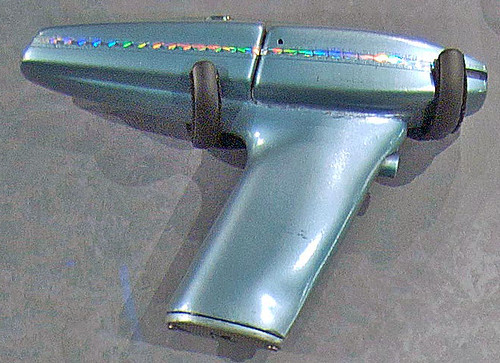I'd argue it's an issue of revolvers vs. semi-automatics. Both are roughly equal in performance, but there are schools of thought in favor of either type.
I'd further argue that the phasers don't actually alternate. Instead, the
Kelvin/TOS weapon is the favored "field piece" and smoothly transitions to the ST3 weapon, then ultimately to the ST5 stype (which carries a teeny weeny Type 1 inside but fires through the Type 2 aperture, even though this functionality is never seen on screen -
http://www.phasers.net/2280/st5prop1.jpg), while the sleeker TMP and ST2 guns are merely officer sidearms that are carried in
addition to the
Kelvin/TOS/ST3/5/6 style, not instead of it. After all, the security detail in ST3 suddenly sports that particular style even though the ship hasn't visited any friendly ports after ST2...
So, the TOS style (let's call it the revolver) is what our working stiffs usually carry in the field. The TMP style (let's call it the semi-auto) looks prettier, and perhaps kicks less, or splatters the target less, and is carried when one wants to make an impression rather than a big hole - ergo, by important personnel on important starships or important locations. The shiny new
Enterprises in TMP and STXI would qualify, even to such a degree that the security details would carry the sissier gun at first - at least for polite indoors work. The grimey old
Kelvin and TOS ship would not.
It just happens that the semi-auto is newer tech than the revolver, and this results in "natural succession": at first, the semi-auto is not trusted for field work, but it does represent the future of phaser sidearms, and by the time of the E-C adventures it has replaced the revolver as the principal type.
As for the functional differences, I guess there are pros and cons for routing the power through a "secondary emitter", TOS/3/5/6 style, versus using the built-in emitter of Type 1 - say, some function that is not squeezeable into the dimensions of Type 1 in the 23rd century yet. The TMP semi-auto fights this size limitation by having four side-by-side emitters in the Type 1 forward piece (as seen close-up when Kirk vapes the Ceti eel), yet may still suffer from unestablished performance shortcomings. TNG era technology either finds some other solution, or then gives up in disgust and adopts wholly separate Types.
As for what this function might be... Well, supposedly Type 2 has higher output settings. Perhaps a small emitter will overheat or otherwise choke at those settings, while greater dimensions allow for better dissipation of waste heat or other side products.
Other possibilities exist, such as the need for a bigger endpiece for better range, or for "broadband" action that allows milder stun and heavier boil than a more tightly "tuned", smaller and less flexible emitter.
Timo Saloniemi













